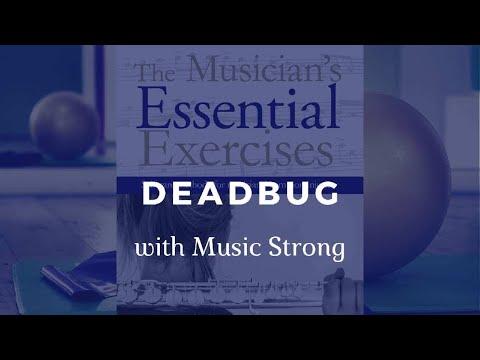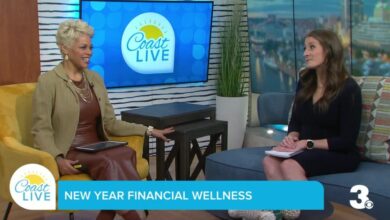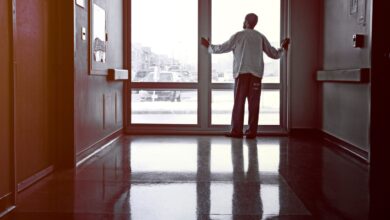Health & Wellness: Your “X” might be causing your back pain

Back pain can encompass everything from a deep low ache at the bottom of the spine to a sharp pain between the shoulder blades and everything in between. Today we’re going to focus in on low back pain among guitarists: main causes and what YOU can do when it strikes.
Culprit 1: Weak Core
If you look at yourself sideways in the mirror and imagine an “X” from your low back to hip flexors and glutes to the core and then arch your low back, that’s what we call Lower Crossed Syndrome. The hip flexors and back get tight, deep core and glutes are weak. If the glutes and deep core, namely TVA, aren’t strong enough to hold your pelvis in neutral, all the load shifts to your low back, causing pain.
When we think “core,” we usually think about the Rectus Abdominus, otherwise known as the “6-pack muscle,” but what we’re referencing here is the non-sexy ab muscle, your transverse abdominus (TVA for short) that wraps around your insides like a corset. This muscle is crucial for supporting you when you play. Want to know how to feel it? Gasp and brace for impact like someone is about to punch you. You’ll feel a deep tightening all around your middle. That’s your TVA.
Technically, your core is everything, but your appendages and any imbalance in the core can cause back pain. Hunching over the guitar? Reaching for the mic with your neck? Slouched on a stool? All these can cause imbalance through the core, and if things are weak, the load shifts to what can handle it, in this case, your low back. Add a heavy guitar, and for us females, the weight of our “girls” and that’s just more weight in the front pulling us forward. That core has to be strong to offset it all!
Culprit 2: Sitting frequently
Whether you’re sitting to play, practice, teach or rehearse, driving to a gig, or spending more time in front of the soundboard or computer, sitting exacerbates Culprit 1. Sitting keeps the hip flexors short and tight and when you press on a muscle, simplistically speaking, it powers down. Your glutes contract to extend your hips, the opposite of sitting, so sitting “shuts them off,” so to speak, and if you aren’t balanced on your sit bones, the low back again takes the brunt of the workload.
What are these “sit bones,” you may ask? They are the bottom of your pelvis, and when you sit with feet flat on the floor, you should feel one bone each in your butt. These are your sit bones, and your spine goes right between them. If you can balance equal weight between them, congratulations! That is proper posture, and your entire spine is now doing the work of holding you upright. If you’re balanced, good posture should feel effortless.
Culprit 3: You use a footstool
This is a sneaky one. A lot of guitarists, especially in the Classical genre, either uses a footstool or prop to elevate their left knee or even put their left foot on top of their right to help support the proper positioning of the guitar. This can be compounded by crossing your legs (ever notice you tend to cross one more than another?) or even sitting with one leg crossed, tucked underneath. What happens in these positions is that it creates an imbalance in the hips, pushing one hip higher than the other.
Solution 1: Stretch those hip flexors
 This can be done sitting or standing. The key is to tuck your pelvis under (think a dog with a tail between its legs), squeeze your butt, and only slightly lean forward. This is an active stretch and activates Sherrington’s Law which states that you cannot have two opposing muscle forces contract at the same time. If you’re squeezing your glutes, your hip flexors have to relax. See this video for more tips.
This can be done sitting or standing. The key is to tuck your pelvis under (think a dog with a tail between its legs), squeeze your butt, and only slightly lean forward. This is an active stretch and activates Sherrington’s Law which states that you cannot have two opposing muscle forces contract at the same time. If you’re squeezing your glutes, your hip flexors have to relax. See this video for more tips.
Solution 2: Strengthen your glutes
Bridges are my go-to basic because they’re easy to progress but also easy to do incorrectly. Cues: Make sure you tilt your pelvis backwards (think tail between your legs), pull your belly button into your spine, and squeeze your butt like you’re trying to hold in a fart in front of your crush (ahem, we’ve all been there). Lift your hips up, and keep squeezing! See this video for variations.
Solution 3: Strengthen your Core
 This goes right with Solution 2 because while your glutes are technically part of your core, they work together to keep your entire low back/hip region stable and happy. Frequently one, if not both, are weak, which shifts responsibility to your low back. My favorite exercise to target your TVA is the dead bug exercise. The motion of this exercise isn’t what’s important; it’s the things you don’t see. Pull your belly button into your spine and brace like someone is going to punch you. Hold your low back on the floor, and only then lift your legs. Your low back shouldn’t move off that floor no matter what!
This goes right with Solution 2 because while your glutes are technically part of your core, they work together to keep your entire low back/hip region stable and happy. Frequently one, if not both, are weak, which shifts responsibility to your low back. My favorite exercise to target your TVA is the dead bug exercise. The motion of this exercise isn’t what’s important; it’s the things you don’t see. Pull your belly button into your spine and brace like someone is going to punch you. Hold your low back on the floor, and only then lift your legs. Your low back shouldn’t move off that floor no matter what! 
Throw these three exercises together every day for 30 seconds to a minute each and watch the low back pain vanish!
Rock on!
Angela McCuiston, NASM-CPT, CES, SFS, M.M., is the owner of Music Strong, a business that specializes in fitness for musicians. Winner of the 2007 National Flute Association Piccolo Masterclass, she is Assistant Principal/Piccolo of Sinfonia Gulf Coast, a member of the 313th Army Band, and chair of the NFA Performance Health Committee. See her website at MusicStrong.com.
Related




